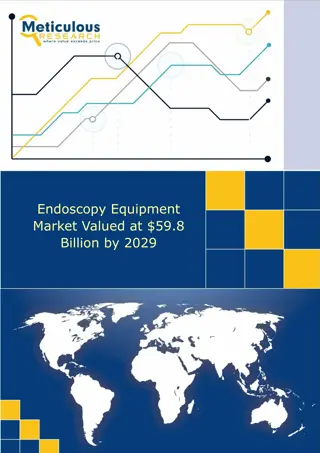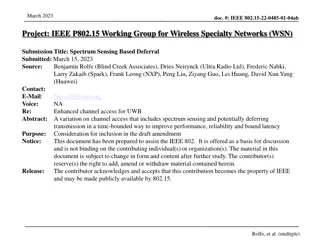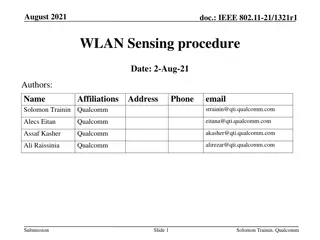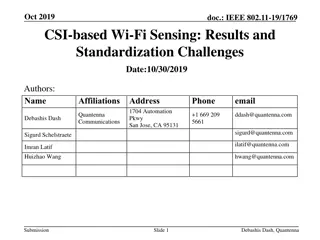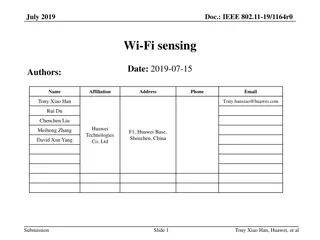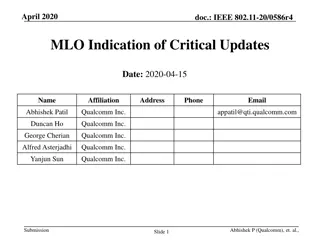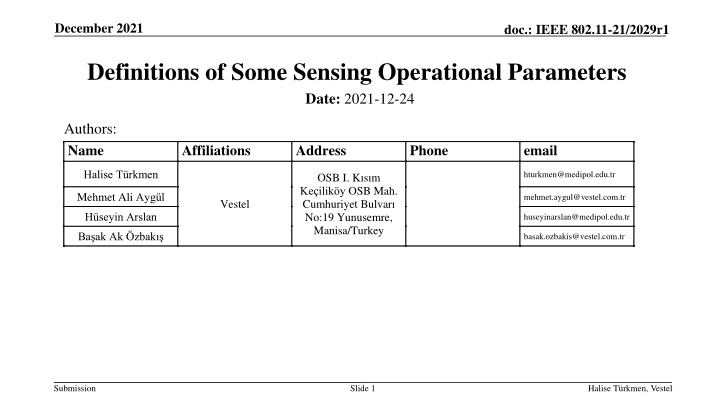
IEEE 802.11-21/2029r1 Sensing Operational Parameters Definitions
This document discusses the definitions of sensing operational parameters in IEEE 802.11-21/2029r1, focusing on negotiation processes, performance adjustments, and predefined parameters for popular use-cases. It emphasizes the importance of defining specific parameters to meet the varied requirements of sensing applications, particularly in the context of NDP transmission parameters. The content also includes an overview of sensing scenarios and use-cases, as well as considerations for negotiating operational parameters in trigger-based sensing sessions.
Download Presentation

Please find below an Image/Link to download the presentation.
The content on the website is provided AS IS for your information and personal use only. It may not be sold, licensed, or shared on other websites without obtaining consent from the author. If you encounter any issues during the download, it is possible that the publisher has removed the file from their server.
You are allowed to download the files provided on this website for personal or commercial use, subject to the condition that they are used lawfully. All files are the property of their respective owners.
The content on the website is provided AS IS for your information and personal use only. It may not be sold, licensed, or shared on other websites without obtaining consent from the author.
E N D
Presentation Transcript
December 2021 doc.: IEEE 802.11-21/2029r1 Definitions of Some Sensing Operational Parameters Date: 2021-12-24 Authors: Name Affiliations Address Phone email Halise T rkmen hturkmen@medipol.edu.tr OSB I. K s m Ke ilik y OSB Mah. Cumhuriyet Bulvar No:19 Yunusemre, Manisa/Turkey Mehmet Ali Ayg l mehmet.aygul@vestel.com.tr Vestel H seyin Arslan huseyinarslan@medipol.edu.tr Ba ak Ak zbak basak.ozbakis@vestel.com.tr Submission Slide 1 Halise T rkmen, Vestel
December 2021 doc.: IEEE 802.11-21/2029r1 Abstract [1] proposes determining some of the sensing operational parameters during the negotiation process of the sensing session setup phase. [2] goes over some adjustable sensing operational parameters affecting sensing performance and suggests the possibility of having predefined sensing operational parameters for popular use-cases [3]. This contribution will define some of these sensing operational parameters. Submission Slide 2 Halise T rkmen, Vestel
December 2021 doc.: IEEE 802.11-21/2029r1 Motivation for Defining Some NDP Transmission Parameters as Sensing Operational Parameters There are many sensing applications of great market value. Each (or groups) of these applications may require some specific parameters to meet their performance requirements, some of which can be found in [3]. Because the measurement of the channel will be made through the NDP, negotiating the transmission parameters of the NDP is important in order to meet the performance requirements of the sensing applications. Submission Slide 3 Halise T rkmen, Vestel
December 2021 doc.: IEEE 802.11-21/2029r1 Sensing Scenario and Use-Cases Overview In an environment, multiple sensing sessions belonging to unique sensing applications can take place simultaneously [1]. Some configuration options can be: 1. Stand-alone device, e.g.: autonomous vehicles 2. AP non-AP STA, non-AP STA non-AP STA (P2P) 3. AP multiple non-AP STA, non-AP STA multiple non-AP STA So far, the types of sensing (based on the measurement) discussed in the group are: Radar (delay/delay-doppler) CSI-based RSSI-based SNR-based (beam SNR) NDP Object/ Action 1 STA Signal reflection 2 NDP AP non-AP STA Object/ Action NDP non-AP STA non-AP STA AP non-AP STA Object/Action Object/Action 3 non-AP STA non-AP STA non-AP STA non-AP STA Submission Slide 4 Halise T rkmen, Vestel
December 2021 doc.: IEEE 802.11-21/2029r1 Negotiating Operational Parameters For trigger-based sensing, two options: Negotiation during sensing session setup Pros: Only transmitted once during a session. Cons: Cannot adapt to changing requirements. Session will need to be terminated and re-negotiated. Negotiation during measurement setup Pros: Can transmit as necessary Cons: RSTA may not be able to support these parameters Suggestion: Negotiating operational parameters should be compulsory in the sensing session setup and optional in the measurement setup. If the operational parameters are not defined in the measurement setup, they are assumed unchanged Submission Slide 5 Halise T rkmen, Vestel
December 2021 doc.: IEEE 802.11-21/2029r1 Operational Parameters Affecting Sensing Performance Requested sensing rate The minimum number of frames per second to be transmitted by the transmitting device. Bandwidth or channel width The uninterrupted bandwidth of transmission Beamwidth The relative beamwidth (coarse, mid, fine) for above-60 GHz. Transmit output power The accepted minimum and maximum transmit output power of the transmission. Submission Slide 6 Halise T rkmen, Vestel
December 2021 doc.: IEEE 802.11-21/2029r1 Some Operational Parameters: Requested Sensing Rate 1/2 The frequency of NDP and corresponding measurements determines the time resolution of the measurements. Different sensing applications can have different requirements for the time resolution. For example: Gesture recognition needs more frequent measurements, 100 measurements/second Sleep monitoring can perform well with 5 measurements/second If there are too few NDP and corresponding measurements, the measurements become old, meaning they are outdated. If there are too many NDP and corresponding measurements, the network traffic will increase unnecessarily. The extra measurements may not result in a significant increase in sensing performance. Submission Slide 7 Halise T rkmen, Vestel
December 2021 doc.: IEEE 802.11-21/2029r1 Some Operational Parameters: Requested Sensing Rate 2/2 Transmitting NDPs with a strict rate is not implementable due to equipment shortcomings, no free channels at that time, and collisions. For similar reasons, the specific time interval between consecutive transmissions may not be implementable as well. Suggested definition: Theminimum number of frames per second to be transmitted by the transmitting device. Submission Slide 8 Halise T rkmen, Vestel
December 2021 doc.: IEEE 802.11-21/2029r1 Some Operational Parameters: Bandwidth 1/2 Bandwidth affects range resolution in radar sensing. The wider the bandwidth, the finer the resolution. For autonomous vehicles and V2V scenarios, radar using 802.11p PPDU has been thoroughly studied and found that the 10 MHz BW allowed is not sufficient for the desired range resolution (and thus target separability) while around 100 MHz is sufficient [5]. Therefore, if BW is negotiable, bf amendment can be used in such applications. Bandwidth also increases the number of measurements per frame for CSI- based sensing, therefore capturing more information, even if a compressed CSI matric is reported. Submission Slide 9 Halise T rkmen, Vestel
December 2021 doc.: IEEE 802.11-21/2029r1 Some Operational Parameters: Bandwidth 2/2 The BW information of a frame is present in the control fields; therefore, the receiving responder will know what it is, and it does not need to be negotiated with the receiving responder. However, the transmitting responder(s) need to know the BW that is required by an application so that it can transmit with the appropriate BW. If it transmits with a random or available BW arbitrarily, it may not be sufficient for the sensing application and will pointlessly occupy the channel (sensing will fail). If the BW is too wide, sensing will be successful, but resources will be wasted. Suggested definition: Minimum acceptable contiguous BW for the sensing application Submission Slide 10 Halise T rkmen, Vestel
December 2021 doc.: IEEE 802.11-21/2029r1 Some Operational Parameters: Beamwidth 1/2 This parameter is specifically for above-60 GHz. The beamwidth affects the area of the object/target and the number of objects which gets illuminated. This effects the number of taps at the receiver. It can provide spatial resolution. If the beam is too wide, there may be more objects than the sensing application is able to resolve. If the beam is too narrow, the transmitter will need to transmit more beams in different directions to illuminate the same object/area. Submission Slide 11 Halise T rkmen, Vestel
December 2021 doc.: IEEE 802.11-21/2029r1 Some Operational Parameters: Beamwidth 2/2 Determining or standardizing a quantitative value for the beamwidth is not feasible because it is strongly hardware dependent. Therefore, it would be better to determine relative or qualitative terms which reflect the transmitting devices' capabilities. Suggested definition: The beamwidth of the transmission in above-60 GHz is the beamwidth of the NDP relative to the device capabilities. Values are: coarse, mid, fine beam Submission Slide 12 Halise T rkmen, Vestel
December 2021 doc.: IEEE 802.11-21/2029r1 Some Operational Parameters: Transmit Output Power 1/2 In radar-based sensing, the transmission power is directly related to the range or distance that can be measured. There can be some applications which are only interested in objects within a certain radius of the transmitter. Having transmit output power as an operational parameter would prevent unnecessary reflections and computation to remove these reflections, conserve power, reduce interference, improve spectral reuse, etc. Like for BW, the NDP may contain the Tx power in its signalization, however, it will still need to be negotiated if the sensing transmitter is not the sensing receiver. Submission Slide 13 Halise T rkmen, Vestel
December 2021 doc.: IEEE 802.11-21/2029r1 Some Operational Parameters: Transmit Output Power 2/2 Determining a fixed value for the transmit output power may not always be possible due to other restrictions defined by the standard or interference mitigation techniques. Suggested definition: Transmit output power is the requested minimum and maximum transmit output powers of the signal to achieve the sensing performance. Submission Slide 14 Halise T rkmen, Vestel
December 2021 doc.: IEEE 802.11-21/2029r1 SP-1 Do you agree with the following: Negotiating operational parameters should be compulsory in the sensing session setup and optional in the measurement setup. If the operational parameters are not defined in the measurement setup, they are assumed unchanged. Submission Halise T rkmen, Vestel Slide 15
December 2021 doc.: IEEE 802.11-21/2029r1 SP-2 Do you agree with the following: The following parameters* shall be negotiated in the sensing session setup phase and can be optionally negotiated in the measurement setup phase. Requested sensing rate Bandwidth Beamwidth Transmit output power *Note: These may not be the only negotiated parameters. Others may be TBD. Submission Slide 16 Halise T rkmen, Vestel
December 2021 doc.: IEEE 802.11-21/2029r1 SP-3 Do you agree with the following: 11bf should define the following parameters associated with a sensing procedure: requested sensing rate, bandwidth, beamwidth, and transmit output power, as: Requested sensing rate is the minimum number of sensing frames per second to be transmitted by the transmitting device. Bandwidth is the contiguous bandwidth of transmission. Beamwidth of the transmission in above-60 GHz is the beamwidth of the NDP relative to the device capabilities. Values are: coarse, mid, fine beam Transmit output power is the requested minimum and maximum transmit output powers of the signal to achieve the sensing performance. Submission Halise T rkmen, Vestel Slide 17
December 2021 doc.: IEEE 802.11-21/2029r1 References [1] 11-20-1851-01-00bf-overview-of-wi-fi-sensing-protocol [2] 11-21-0365-02-00bf-wi-fi-sensing-parameters [3] 11-20-1712-02-00bf-wifi-sensing-use-cases [4] H. J. Li and Y. W. Kiang, 10 Radar and inverse scattering, in The Electrical Engineering Handbook, W.K. CHEN, Ed. Burlington: Academic Press, 2005, pp. 671 690. [5]C. Sturm, E. Pancera, T. Zwick and W. Wiesbeck, "A novel approach to OFDM radar processing," 2009 IEEE Radar Conference, Pasadena, CA, USA, 2009, pp. 1-4. [6] Zheng Yang, Zimu Zhou, and Yunhao Liu. 2013. From RSSI to CSI: Indoor localization via channel response. ACM Comput. Surv. 46, 2, Article 25 (November 2013), 32 pages. Submission Slide 18 Halise T rkmen, Vestel
December 2021 doc.: IEEE 802.11-21/2029r1 Back-up Slides Submission Slide 19 Halise T rkmen, Vestel
December 2021 doc.: IEEE 802.11-21/2029r1 Requested Sensing Rate ? Affects unambiguous range, ?????= Affects number of measurements and sensing resolution 2?????? = ????? ?????????? ?????????, ? = ????? ?? ??? ? Example impact: Network Load (%) Applications Presence detection, human counting, localization, motion detection, proximity detection Detection of humans in car, gesture recognition (finger + hand), human counting, localization, speed detection Intruder detection, gesture detection (body), aliveness detection, face/body recognition, fall detection, sneeze detection, driver sleepiness detection, heart rate, breathing rate measurements, person localization and tracking, 2 5 10 Submission Slide 20 Halise T rkmen, Vestel
December 2021 doc.: IEEE 802.11-21/2029r1 Contiguous Bandwidth or Channel Width 2?, maximum velocity, ????=?? ? = ???????? , ? = ????????? c Affects range resolution, ? = 2. Example impact: Range Separability (m) Applications 3D vision 0.1 Presence detection, human counting, human tracking, breathing rate, heart rate detection, sneeze sensing, fall detection, detection of human in car, Person tracking, motion/gesture detection, 0.5 1 Proximity detection 2 Submission Slide 21 Halise T rkmen, Vestel
December 2021 doc.: IEEE 802.11-21/2029r1 Beamwidth 60 GHz: Affects angular resolution, e.g., ? = 2?sin? 2 and the beamwidth ? = ????? ?????, ? = ??????? ?????????? ?? ???????? ??????? ??? ???????, ? = ???????? Example impact: Angular Separability ( ) Applications 3D vision 3 3-4 5-6 Presence detection, human counting, localization, detection of humans in car Sneeze detection Submission Slide 22 Halise T rkmen, Vestel
December 2021 doc.: IEEE 802.11-21/2029r1 Transmit Output Power Affects the maximum detectable range and resilience to interference. Example impact: Maximum Range/Distance (m) Applications Gesture recognition (finger movement), aliveness detection, face/body recognition, proximity detection, Gesture recognition (hand movement), human detection in car, driver sleepiness detection, breathing rate, heart rate measurement Presence detection (home security), human counting (meeting room), human localization, motion detection, human tracking, gesture recognition (full body movement), fall detection, sneeze detection, 3D vision Presence detection (number of persons in room, store sensing), human counting (store sensing) 1 5 10 >10 Submission Slide 23 Halise T rkmen, Vestel












